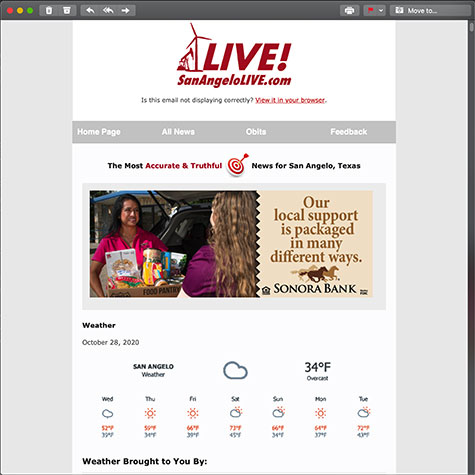By Jaden Edison, The Texas Tribune
AUSTIN, TX — More than 300 Texas school districts and charter schools have signaled plans to use a state-developed reading and language arts curriculum that attracted national attention last year for its heavy references to the Bible and Christianity, according to data obtained by The Texas Tribune.
That number represents about a quarter of Texas’ 1,207 districts and charters and could still grow before the state publishes official data in the early fall. But the preliminary numbers offer an early glimpse into demand for the elementary school materials narrowly approved by the State Board of Education in November.
The Texas Education Agency asks schools to submit information on the instructional materials they plan to use each year to ensure their compliance with state learning standards. The Tribune obtained data through an open records request on the schools planning to use the TEA’s new Bluebonnet curriculum, which includes the religion-infused reading lessons as well as phonics and math materials.
According to the data, about 595 districts and charters signed up as of late June to use at least some parts of the curriculum, and about 317 said they would use the reading lessons. Adoption of the reading curriculum was most prevalent in the Kilgore, Amarillo and Victoria regions; it was least prevalent around Beaumont, Austin and El Paso.
The Tribune reached out to over a dozen district officials and school board members to ask them about their decision on whether to adopt the curriculum. Of the districts that do plan to use the reading materials, some said the religious components did not factor into their choice. Their reasons included accessing the additional funding districts qualify for when they opt in; aligning their instruction with what the state expects children to learn; and avoiding punitive measures from the state if students do not perform up to par on Texas’ standardized exams, which could include removal of a district’s superintendent and elected board members.
“We struggle financially to meet the needs of our people,” said Stacey Brister, superintendent of the Little Cypress-Mauriceville school district, in rural Southeast Texas. “If they're going to give you additional monies to buy resources that you might not be able to have, then you have to take a serious look at stuff like that.”
Switching from one curriculum to another is a significant undertaking, and other schools could be taking a wait-and-see approach before deciding whether to use the state-designed materials.
“We wouldn't expect universal uptake within the first few years for any kind of massive shift in policy like this,” said Mary Lynn Pruneda, director of education and workforce policy for the research and advocacy group Texas 2036.
The state education agency did not comment on whether the current demand for Bluebonnet’s reading portion matched its expectations. In a statement, it expressed a commitment to supporting any district using instructional materials “aligned to state standards and built based on the best cognitive science” and noted that Bluebonnet successfully went through the State Board of Education’s exhaustive vetting process.
“Evidence clearly indicates that high-quality instructional materials lead to increased learning for students and, ultimately, success in the classroom and beyond,” said TEA spokesperson Jake Kobersky.
Bluebonnet was approved by a narrow 8-7 majority of the State Board of Education last year, overcoming concerns that the reading lessons favored Christianity over other faith traditions, pushback from advocacy groups that the materials inappropriately prioritized preaching over teaching, and worries from Texans that the curriculum would isolate some students and grant the state too much say in how children learn about religion.
The American Civil Liberties Union of Texas and other organizations sent a letter to districts earlier this year urging them to avoid the reading materials, saying they would "unlawfully impose a set of religious beliefs upon your students and violate their constitutionally guaranteed right to be free from religious coercion." The groups suggested a willingness to pursue legal action to stop schools from teaching the curriculum.
Supporters of Bluebonnet say the biblical references will provide students with an enhanced understanding of U.S. and world history. They say the materials cover a broad range of faiths and only make references to religion when appropriate.
Bluebonnet is free to use. The state believes its scripted teaching format will help ensure educators can spend more time focusing on instruction and less time on planning. It offers an incentive of $60 per student to districts that choose to use it, which can help cover printing costs.
The religious references only make up a fraction of the reading curriculum, and using Bluebonnet does not necessarily mean a school plans to teach biblical lessons in their classrooms. They could, for example, ignore any chapters that reference Christianity and other religions. Or they could choose to heavily lean on the biblical lessons while using another curriculum for other teachings.
Some districts said their decision to use Bluebonnet had nothing to do with religion.
“We don't make it an issue,” said Michael Lee, superintendent of the Booker Independent School District, located in a conservative Christian community in the Texas Panhandle. “If students ask questions, we'll answer them. We're not going to push our own values and beliefs on them in the classroom.”
The Booker district instead said it adopted the curriculum because its leaders wanted learning materials that directly aligned with what the state requires students to know — similar to what the district had when it used CSCOPE, a curriculum delivery system that provided lesson plans to Texas schools over a decade ago before lawmakers complained that it contained an anti-American agenda.
The roughly 330-student rural district hopes Bluebonnet will offer that alignment and help students perform better on standardized tests. As a school community with a predominantly low-income student body, it also does not want to leave the money that comes with the state curriculum on the table.
Bluebonnet is Texas’ version of a curriculum developed by a New York-based publishing company called Amplify, which did not include the biblical materials. Hundreds of districts used Amplify before the state awarded an $84 million contract to another company for revisions to the program, as first reported by the education news organization The 74.
The Little Cypress-Mauriceville school district in rural East Texas was one of them. District leaders see Bluebonnet as “just a continuation” of the curriculum they started using about three years ago, with the added bonus of more state funding and an opportunity to align their teachings with state requirements and improve their rating in Texas’ academic accountability system. The schools’ largely conservative community has not raised any concerns with Bluebonnet’s religious components, said Brister, the superintendent.
Texas has recently endeavored to expose public school students to more religion, specifically Christianity. In the last legislative session, lawmakers passed bills allowing districts to establish a policy providing students and staff a daily period of prayer or time to read a religious text, requiring that every public school classroom display a poster of the Ten Commandments, and providing $243 million to the state education agency to support schools adopting Bluebonnet.
Some districts using Bluebonnet acknowledge that the presence of religion in schools can present difficulties to the teachers wanting to ensure every child in their classroom feels included and represented.
Jessica Parker, the K-12 principal and curriculum director in rural West Texas’ Irion County Independent School District, appreciates the funding the district gets for using Bluebonnet and how it helps keep teachers aligned with state requirements. She believes it will be important that teachers review their lessons and identify any aspects that may not resonate well with children. She also encourages her educators to actively inform parents about what’s happening in the classroom.
“We don't want to cut things out,” Parker said. “But we will if it is what’s absolutely necessary to avoid trying to portray that we fall in a certain religious line or we fall in a certain political line.”
For now, most of the state’s schools will likely continue on without Bluebonnet’s reading lessons.
Sandy Denning, an associate superintendent who oversees curriculum for the Keene Independent School District, told the Tribune that Bluebonnet’s reading materials currently do not meet the level of rigor the district wants. She did not point to any specific parts but described the problem as “across the board.”
Mackee Mason, chief academic officer for Austin Achieve Public Schools, a charter school network, identified the same concern, adding that the curriculum does not do a good job incorporating phonics or the science of reading, a widely used body of research that focuses on how children learn to read.
Both Keene ISD and Austin Achieve plan to use the math portion of the curriculum.
Subscribe to the LIVE! Daily
Required






Post a comment to this article here: